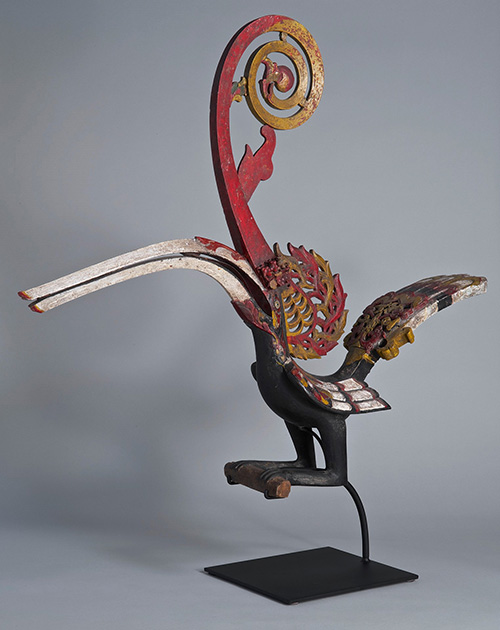FROM THE LIBRARIAN: FRESH FINDS FROM THE SOUTHEAST ASIA COLLECTION
FROM THE LIBRARIAN: FRESH FINDS FROM THE SOUTHEAST ASIA COLLECTION
September 3, 2019
As I settle into my new position as Librarian for South and Southeast Asian Studies, I am coming across all sorts of treasures in the collection. Recently, I had the pleasure of taking a tour of the Art Gallery’s holdings on West Campus with the Curator for Indo-Pacific Art, Ruth Barnes. In addition to the excellent company and a chance to finally see West Campus, I had a fantastic time discovering more about our holdings for insular Southeast Asian art. While students of art history and fine arts will be immediately drawn to these materials, a familiarity with material and visual culture can support and add much needed nuance to any area studies research and/or teaching project.
As a scholar focused on Northeast India and adjacent areas of Myanmar and Bangladesh, I have a soft spot in my heart for Hornbills. Turns out, I am not alone, and hornbills feature prevalently in Southeast Asian art as far east as Indonesia. Look at this amazing find from Borneo:

There are a ton of interesting questions that can emerge from seeing and thinking about an awesome piece like this. We might ask questions about human-animal relations, hornbills in mythology and religious practice, or how this image has changed over time. We might also think about the choices made by the artist. Is this highly stylized image prescribed by community practice or does it reflect individual style? For me, art always brings up questions of identity and politics, and interacting with an awesome piece like this can spur me on to looking more at the political and historical circumstances of Borneo.
This particular item, I learned, was made by a member of the Iban community, about whom we have a quite extensive collection of major publications. The sculpture is of a Rhinoceros Hornbill, which features prominently in art from the region. It also looks like this particular species is important in religious practice in the area. As with any good topic of research, though, this opens up a whole host of other awesome questions, all motivated by this fantastic sculpture.
Of interest to many faculty at Yale, surrounding universities, and internationally, we have a huge collection of wayang puppets from Indonesia. This is just one of over a dozen chests of puppets:

Staff are hard at work cataloguing these puppets, and it turns out that this collection (donated by Dr. Walter Angst and Sir Henry Angest) is the world’s largest. Who knew?! These intriguing objects are visually quite striking, all the more so when used in performance. The myths that the performances are based on often have imbedded moral lessons as well, giving us a colorful and engaging lense through which to study Indonesian culture. The stories als reveal international trends and great power politics in the region, with mythical influences from India, Persia, and China central to most repertoires. In writing this, I even came across a rendition of Star Wars modified for wayang!
Researchers at Yale can arrange a time to visit these and other holdings at the Art Gallery and West Campus, and I highly recommend that you take advantage of this fantastic opportunity.
If any of this has sparked your interest and you want to explore more ways of integrating artistic materials into your research or learn more about Yale’s world-leading collections in these areas, please feel free to reach out to me by email, brandon.miliate@yale.edu or stop by my office in the Southeast Asia Reading Room in Sterling Memorial Library 214A.
Brandon J. Miliate, PhD is a former Librarian for South and Southeast Asian Studies at Yale University. When he is not exploring and building the Southeast Asia Collection, he can found at home playing the harp, painting, or taking on yet another language (Vietnamese sounds nice!).
Learn more about the Southeast Asia Collection
Also, check out Brandon’s new LibGuide, Methods and Materials for South/Southeast Asian Studies for a guided introduction to our collection and ways you might consider using these materials in your own research.
